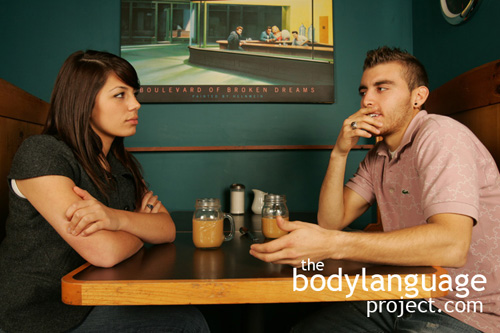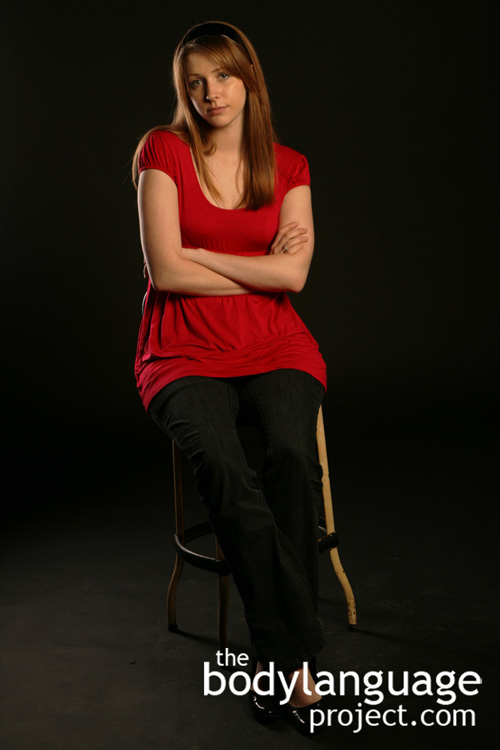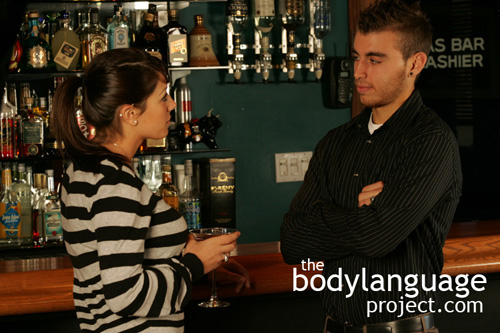Body Language of Arms Akimbo
 Cue: Arms Akimbo
Cue: Arms Akimbo
Synonym(s): Hands Akimbo, Hands On Hips, Fists On Haunches, Pot With Two Handles, “Captain Morgan stance” (The), Straddle Stance, Super Man Stance, Wonder Women Stance, Amy Cuddy Pose (The).
Description: The hands are placed on each hip making the elbows flair out.
In One Sentence: Arms akimbo is an expansive posture used to make the body appear larger and taking up more space thereby creating dominance.
How To Use it: Use this posture to boost your confidence before an important presentation. Research has found that expansive postures such as this one helps boost testosterone and simultaneously lowers the stress hormone cortisol. Likewise, the posture makes the body appear larger and therefore, increases the perception of dominance. Arms akimbo also shows an eagerness to get down to business as it is classified as a “ready posture.” Dominant postures are important when you want to take a leadership role and are prepared to accept the responsibility which comes with authority.
Context: a) Social b) Dating
Verbal Translation: a) “I’m much bigger than I appear, so you must respect me when I puff out like this.” “There are issues here”, “Things are not right”, “I’m standing my ground” or b) “I’m a virile male so check me out!”
Variant: The “Captain Morgan stance” was made popular by a widespread media advertising campaign depicting regular people in the posture. It includes one leg propped up, opening the legs and “exposing the genitals,” with one hand place on the thigh, and the other hand left lose or placed on the hips. This is a dominant, full peacock gesture, as it exposes the genital area for all to view and puffs out the chest, head held high. The aim of the posture is to claim the right to space and soak in the admiration of others.
Alternatively, one hand might be placed on the hips with the other hand gesturing. The thumbs might also be tucked into the belt or into belt loops serving to “frame the genitals.” Women usually aim their fingers backwards to point to their backside rather than their crotch.
Another variant, the straddle stance, is a stable standing position where the legs are straight, and set at, or slightly wider than shoulder width. The weight is bore by both feet evenly. It is normal for men rather than women to hold this stance. It is a display of dominance and confidence, and that a person is “standing their ground.”
Cue In Action: a) Mom is in a good mood until her 6 year old is caught eating sweets from the cupboard. Mom strides to her child, puts her hands on her hips, then begins ecturing him about the harms of junk food. Mom went over to junior, put her hands on her hips, then began lecturing him with a lesson about junk food. b) To make Dave stand out on a dating show, he put his arms on his hips when he stood next to the other contestants.
Meaning and/or Motivation: Having the hands on the hips has roots in evolution. It makes the body take up more space, just like a peacock, and hence appear larger which can be attractive to other men who seek leadership or to women seeking a healthy mate. While in the stance, all the fingers also curl inward so that they point toward the crotch. This draws attention toward the genitals, which punctuates the point even further.
Women will also hold the arms akimbo posture, although more rarely, as it can be seen as assertive (as it draws attention to the genital area by pointing). When women do hold the posture, they usually hold their hands on their hips and point their fingers to their buttocks. Pointing therefore, puts emphasis on our best assets as we state our case! Having the fingers pointed backwards, as women do, is also a more inquisitive, rather than authoritarian, posture. It says, “We have issues.”
The hands-on-hips is also a ready posture when it does not accompany more dominant cues in the cluster. In this case, it appears like a runner at the gate prepared to jump at an opportunity.
Cue Cluster: The cue cluster accompanying the hands-on-hips also includes an upright posture, chin up, chest out and the legs at slightly wider than shoulder width. We may see other dominant gesture such as “batoning” (see Batoning) and finger pointing.
Body Language Category: Ready posture, Confident, Dominant body language, Expansive movements, High confidence body language, Threat displays, Hostile body language.
Resources:
Allen, Jill; Sarah J. Gervais and Jessi L. Smith. Sit Big to Eat Big: The Interaction of Body Posture and Body Concern on Restrained Eating. Psychology of Women Quarterly 2013. 37(3): 325-336. DOI: 10.1177/0361684313476477pwq.sagepub.com
http://bodylanguageproject.com/articles/sit-big-to-eat-big-how-constrictive-postures-reduce-food-consumption/
Arnette, S. L., & Pettijohn, T. F., II. (2012). The effects of posture on self-perceived leadership. International Journal of Business and Social Science, 3, 8–13.
Bohns, Vanessa K. and Scott S. Wiltermuth. It Hurts When I Do This (Or You Do That): Posture And Pain tolerance. Journal of Experimental Social Psychology. 2012. 48: 341-345.
http://bodylanguageproject.com/articles/dominant-and-submissive-postures-affects-more-than-public-perception-it-also-affects-felt-pain-and-physical-strength/
Briñol, P., Petty, R. E., & Wagner, B. (2009). Body posture effects on self-evaluation: A self-validation approach. European Journal of Social Psychology, 39, 1053–1064.
Bartholomewn, Morgan E.; Sheri L. Johnson. Nonverbal Dominance Behavior Among Individuals at Risk for Mania. Journal of Affective Disorders. 2014. 159: 133-138.
Bohns, Vanessa K. and Scott S. Wiltermuth. It Hurts When I Do This (Or You Do That): Posture And Pain tolerance. Journal of Experimental Social Psychology. 2012. 48: 341-345.
http://bodylanguageproject.com/articles/dominant-and-submissive-postures-affects-more-than-public-perception-it-also-affects-felt-pain-and-physical-strength/
Carney, Dana R.; Amy J.C. Cuddy; Andy J. Yap. Power Posing: Brief Nonverbal Displays Affect Neuroendocrine Levels and Risk Tolerance. Psychological Science, 2010; 21 (10): 1363-1368.
http://bodylanguageproject.com/articles/benefits-power-posing-high-stakes-performance/
Cesario, J., & McDonald, M. M. (2013). Bodies in context: Power poses as a computation of action possibility. Social Cognition, 31, 260–274.
Cuddy, A. J. C., Wilmuth, C., Yap, A. J., & Carney, D. R. (in press). Preparatory power posing affects nonverbal presence and job interview performance. Journal of Applied Psychology.
Cuddy, Amy J.C., Caroline A. Wilmuth, and Dana R. Carney. The Benefit of Power Posing Before a High-Stakes Social Evaluation. Harvard Business School Working Paper, No. 13-027, September 2012.
Cashdan, Elizabeth. Smiles, Speech, and Body Posture: How Women and Men Display Sociometric Status and Power. Journal of Nonverbal Behavior. 1998. 22(4): 209-228.
de Lemus, Soledad; Russell Spears and and Miguel Moya. The Power of a Smile to Move You: Complementary Submissiveness in Women’s Posture as a Function of Gender Salience and Facial Expression. Personality and Social Psychology Bulletin. 2012. 38(11): 1480-1494.
Fischer, Julia; Peter Fischer; Birte Englich; Nilüfer Aydin and Dieter Frey. Empower My Decisions: The Effects of Power Gestures on Confirmatory Information Processing. Journal of Experimental Social Psychology. 2011. 47: 1146-1154.
http://bodylanguageproject.com/articles/downside-power-posing-body-language-looking-power-posing-action-study/?preview=true
http://bodylanguageproject.com/articles/benefits-power-posing-high-stakes-performance/
Gorkan Ahmetoglu, Viren Swami. Do Women Prefer “Nice Guys?” The Effect Of Male Dominance Behavior On Women’s Ratings. Social Behavior And Personality, 2012; 40(4), 667-672.
http://bodylanguageproject.com/articles/how-to-significantly-increase-male-attractiveness-with-simple-body-language-nice-guys-finish-last-once-again/
Hewes, Gordon (1957). “The Anthropology of Posture.” In Scientific American (Vol. 196), pp. 122-32.
Huang, L., Galinsky, A. D., Gruenfeld, D. H., & Guillory, L. E. (2011). Powerful postures versus powerful roles: Which is the proximate correlate of thought and behavior? Psychological Science, 22, 95–102.
James, W. (1950). The Principles of Psychology. New York, NY: Dover. (Original work published 1890)
Johnson, Richard R. and Aaron, Jasmine L. Adults’ beliefs regarding nonverbal cues predictive of violence. Criminal Justice and Behavior. 2013. 40(8): 881-894.
Knapp, Mark L. (1972). Nonverbal Communication in Human Interaction (New York: Holt, Rinehart and Winston).
Locke, Connson C. and Cameron Anderson. The Downside of Looking Like a Leader: Leader’s Powerful Demeanor Stifles Follower Voice in Participative Decision-Making.. Academy of Management Annual Meeting Proceedings. 2010. 8(1): 1-6.
http://bodylanguageproject.com/articles/power-body-language-goes-far/
Li Huang, Adam D. Galinsky, Deborah H Gruenfeld and Lucia E. Guillory. Powerful Postures Versus Powerful Roles: Which Is the Proximate Correlate of Thought and Behavior? 2011, Psychological Science; 22(1): 95–102.
http://bodylanguageproject.com/articles/whats-more-powerful-nonverbal-power-or-real-power/
Laird, J. D., & Lacasse, K. (2014). Bodily influences on emotional feelings: Accumulating evidence and extensions of William James’s theory of emotion. Emotion Review, 6, 27–34.
Lee, E. H., & Schnall, S. (2014). The influence of social power on weight perception. Journal of Experimental Psychology: General, 143, 1719–1725.
Mehrabian, Albert (1969). “Significance of Posture and Position in the Communication of Attitude and Status Relationships.” In Psychological Bulletin (Vol. 71), pp. 359-72.
Mehrabian, Albert Holzberg, Jules D. (editor). Inference of Attitudes From the Posture, Orientation and Distance of a Communicator. Journal of Consulting and Clinical Psychology. 1968. 32(3): 296-308.
Mehrabian, Albert Deese, James (editor). Significance of posture and position in the communication of attitude and status relationships. Psychological Bulletin. 1969. 71(5): 359-372
Matsumoto, David and Hwang, Hyi Sung. Evidence for a nonverbal expression of triumph. Evolution and Human Behavior. 2012. 33(5): 520-529.
Matsumoto, D., & Willingham, B. (2006). The thrill of victory and the agony of defeat: Spontaneous expressions of medal winners of the 2004 Athens Olympic Games. Journal of Personality and Social Psychology, 91(3), 568–581.
Mouterde, S. C., Duganzich, D. M., Molles, L. E., Helps, S., Helps, R., & Waas, J. R. (2012). Triumph displays inform eavesdropping little blue penguins of new dominance asymmetries. Animal Behaviour, 83, 605–611.
Morris, Desmond (1994). Bodytalk: The Meaning of Human Gestures (New York: Crown Publishers).
Michalak, J., Mischnat, J., & Teismann, T. (2014). Sitting posture makes a difference: Embodiment effects on depressive memory bias. Clinical Psychology & Psychotherapy, 21, 519–524.
Minvaleev, R. S., Nozdrachev, A. D., Kir’yanova, V. V., & Ivanov, A. I. (2004). Postural influences on the hormone level in healthy subjects: I. The cobra posture and steroid hormones. Human Physiology, 30, 452–456.
Nair, S., Sagar, M., Sollers, J., III, Consedine, N., & Broadbent, E. (2014). Do slumped and upright postures affect stress responses? A randomized trial. Health Psychology. Advance online publication. doi:10.1037/hea0000146
Pease, Barbara and Allan Pease. 2006. The Definitive Book of Body Language Hardcover. Bantam.
Park, Lora E.; Lindsey Streamer; Li Huang and Adam D. Galinsky. Stand Tall, But Don’t Put Your Feet Up: Universal and Culturally-Specific Effects of Expansive Postures On Power. Journal of Experimental Social Psychology. 2013; 49: 965–971.
http://bodylanguageproject.com/articles/are-expansive-postures-of-power-universal-or-cultural/
Ranehill, Eva; Anna Dreber; Magnus Johannesson; Susanne Leiberg; Sunhae Sul and Roberto A. Weber. Assessing the Robustness of Power Posing: No Effect on Hormones and Risk Tolerance in a Large Sample of Men and Women. Psychological Science, March, 2015. doi: 10.1177/0956797614553946 http://bodylanguageproject.com/articles/power-posing-no-effect-hormones-amy-cuddy-wrong/
Riskind, J. H. (1984). They stoop to conquer: Guiding and selfregulatory functions of physical posture after success and failure. Journal of Personality and Social Psychology, 47, 479–493.
Riskind, J. H., & Gotay, C. C. (1982). Physical posture: Could it have regulatory or feedback effects on motivation and emotion? Motivation and Emotion, 6, 273–298.
Rule, Nicholas, O.; Reginald B. Adams Jr.; Nalini Ambady and Jonathan B. Freeman. Perceptions Of Dominance Following Glimpses Of Faces And Bodies. Perception. 2012; 41: 687-706 doi:10.1068/p7023
http://bodylanguageproject.com/articles/people-can-read-dominance-split-second
Ranehill, Eva; Anna Dreber; Magnus Johannesson; Susanne Leiberg; Sunhae Sul and Roberto A. Weber. Assessing the Robustness of Power Posing: No Effect on Hormones and Risk Tolerance in a Large Sample of Men and Women. Psychological Science, March, 2015. doi: 10.1177/0956797614553946 http://bodylanguageproject.com/articles/power-posing-no-effect-hormones-amy-cuddy-wrong/
Stanton, Steven J. and Robin S. Edelstein. The Physiology of Women’s Power Motive: Implicit Power Motivation is Positively Associated With Estradiol Levels in Women. Journal of Research in Personality. 2009. 43: 1109-1113.
http://bodylanguageproject.com/articles/the-estrogen-factor-the-search-for-nonverbal-power-in-women/
Stanton, Steven J. The Essential Implications of Gender in Human Behavioral Endocrinology Studies. Frontiers in Behavioral Neuroscience. 2011. 5(9): 1-3. doi: 10.3389/fnbeh.2011.00009
http://bodylanguageproject.com/articles/a-critical-commentary-on-amy-cuddys-power-posing/
Sturman, Edward D. Invluntary Subordination and Its Relation to Personality, Mood,
and Submissive Behavior. Psychological Assessment. 2011. 23(1): 262-276 DOI: 10.1037/a0021499
http://bodylanguageproject.com/articles/nonverbal-submission-men-women-depression-critical-examination-use-disuse-submission/
Stepper, S., & Strack, F. (1993). Proprioceptive determinants of emotional and nonemotional feelings. Journal of Personality and Social Psychology, 64, 211–220.
Strelan, P., Weick, M., & Vasiljevic, M. (2013). Power and revenge. British Journal of Social Psychology, 53, 521–540.
Tiedens, L. Z., & Fragale, A. R. (2003). Power moves: Complementarity in dominant and submissive nonverbal behavior. Journal of Personality and Social Psychology, 84,
558–568.
Tomi-Ann, Roberts and Yousef Arefi-Afshar. Not All Who Stand Tall Are Proud: Gender Differences in the Proprioceptive Effects of Upright Posture. Cognition and Emtion. 2007. 21(4):714-727.
http://bodylanguageproject.com/articles/do-women-benefit-from-power-posing-study-suggests-not/
Tracy, J. L., & Matsumoto, D. (2008). The spontaneous expression of pride and shame: Evidence for biologically innate nonverbal displays. Proceedings from the National Academy of Sciences, 105(33), 11655–11660.
Tracy, J. L., & Robins, R. W. (2007). The prototypical pride expression: Development of a nonverbal behavior coding system. Emotion, 7(4), 789–801.
Tiedens, Larissa Z. and Alison R. Fragale. Power Moves: Complementarity in Dominant and Submissive Nonverbal Behavior. Journal of Personality and Social Psychology. 2003, 84(3): 558–568.
Welker, K. M., Oberleitner, D. E., Cain, S., & Carré, J. M. (2013). Upright and left out: Posture moderates the effects of social exclusion on mood and threats to basic needs. European Journal of Social Psychology, 43, 355–361.
Yap, Andy J. Abbie S. Wazlawek, Brian J. Lucas, Amy J. C. Cuddy, Dana R. Carney. The Ergonomics of Dishonesty: The Effect of Incidental Posture on Stealing, Cheating, and Traffic Violations, 24(11); 2281-2289.
http://bodylanguageproject.com/articles/body-posture-physical-environment-determine-feelings-and-behaviour-study/
 Cue: Arms Crossed With Gripped Arm or Reinforced Arm Cross
Cue: Arms Crossed With Gripped Arm or Reinforced Arm Cross



